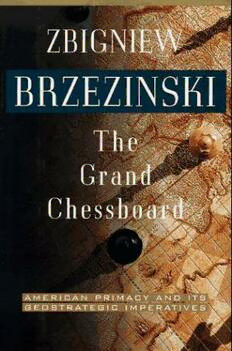
The Grand Chessboard: American Primacy And Its Geostrategic Imperatives PDF
Preview The Grand Chessboard: American Primacy And Its Geostrategic Imperatives
ZBIGNIEW BRZEZINSKI THE GRAND CHESSBOARD American Primacy and Its - Geostrategic Imperatives SA5IC •A Umhi <4-Q|i For my students—to help them shape tomorrow's world CONTENTS List of Maps ix List of Charts and Tables xi Introduction: Superpower Politics xiii 1 Hegemony of a New Type 3 The Short Road to Global Supremacy 3 The First Global Power 10 The American Global System 24 2 The Eurasian Chessboard 30 Geopolitics and Geostrategy 37 Geostrategic Players and Geopolitical Pivots 40 Critical Choices and Potential Challenges 48 3 The Democratic Bridgehead 57 Grandeur and Redemption 61 America's Central Objective 71 Europe's Historic Timetable 81 vii viii CONTENTS 4 The Black Hole 87 Russia's New Geopolitical Setting 87 Geostrategic Phantasmagoria 96 The Dilemma of the One Alternative 118 5 The Eurasian Balkans 123 The Ethnic Cauldron 125 The Multiple Contest 135 Neither Dominion Nor Exclusion1 148 6 The Far Eastern Anchor 151 China: Not Global but Regional 158 Japan: Not Regional but International 173 America's Geostrategic Adjustment 185 7 Conclusion 194 A Geostrategy for Eurasia 197 A Trans-Eurasian Security System 208 Beyond the Last Global Superpower 209 Index 217 MAPS The Sino-Soviet Bloc and Three Central Strategic Fronts 7 The Roman Empire at Its Height 11 The Manchu Empire at Its Height 14 Approximate Scope of Mongol Imperial Control, 1280 16 European Global Supremacy, 1900 18 British Paramountcy, 1860-1914 20 American Global Supremacy 22 The World's Geopolitically Central Continent and Its Vital Peripheries 32 The Eurasian Chessboard 34 The Global Zone of Percolating Violence 53 France's and Germany's Geopolitical Orbits of Special Interest 64 Is This Really "Europe"? 82 Beyond 2010: The Critical Core of Europe's Security 85 IX x MAPS Loss of Ideological Control and Imperial Retrenchment 94 Russian Military Bases in the Former Soviet Space 108 The Eurasian Balkans 124 Major Ethnic Groups in Central Asia 126 The Turkic Ethnolinguistic Zone 137 The Competitive Interests of Russia, Turkey, and Iran 138 Caspian-Mediterranean Oil Export Pipelines 146 Boundary and Territorial Disputes in East Asia 155 Potential Scope of China's Sphere of Influence and Collision Points 167 Overlap Between a Greater China and an American-Japanese Anti-China Coalition 184 LIST OF CHARTS AND TABLES The Continents: Area 33 The Continents: Population 33 The Continents: GNP 33 European Organizations 58 EU Membership: Application to Accession 83 Demographic Data for the Eurasian Balkans 127 Asian Armed Forces 156 XI INTRODUCTION Superpower Politics E VER SINCE THE CONTINENTS started interacting politically, some five hundred years ago, Eurasia has been the center of world power. In different ways, at different times, the peo- ples Inhabiting Eurasia—though mostly those from its Western Eu- ropean periphery—penetrated and dominated the world's other regions as individual Eurasian states attained the special status and enjoyed the privileges of being the world's premier powers. The last decade of the twentieth century has witnessed a tec- tonic shift in world affairs. For the first time ever, a non-Eurasian power has emerged not only as the key arbiter of Eurasian power relations but also as the world's paramount power. The defeat and collapse of the Soviet Union was the final step in the rapid ascen- dance of a Western Hemisphere power, the United States, as the sole and, indeed, the first truly global power. Eurasia, however, retains Its geopolitical importance. Not only is its western periphery—Europe—still the location of much of the world's political and economic power, but its eastern region— Asia—has lately become a vital center of economic growth and ris- ing political influence. Hence, the issue of how a globally engaged xin xiv INTRODUCTION America copes with the complex Eurasian power relationships— and particularly whether it prevents the emergence of a dominant and antagonistic Eurasian power—remains central to America's capacity to exercise global primacy. It follows that—in addition to cultivating the various novel di- mensions of power (technology, communications, information, as well as trade and finance)—American foreign policy must remain concerned with the geopolitical dimension and must employ its in- fluence in Eurasia in a manner that creates a stable continental equilibrium, with the United States as the political arbiter. Eurasia is thus the chessboard on which the struggle for global primacy continues to be played, and that struggle involves geostrategy—the strategic management of geopolitical interests. It is noteworthy that as recently as 1940 two aspirants to global power, Adolf Hitler and Joseph Stalin, agreed explicitly (in the se- cret negotiations of November of that year) that America should be excluded from Eurasia. Each realized that the injection of Amer- ican power into Eurasia would preclude his ambitions regarding global domination. Each shared the assumption that Eurasia is the center of the world and that he who controls Eurasia controls the world. A half century later, the issue has been redefined: will Amer- ica's primacy in Eurasia endure, and to what ends might it be ap- plied? The ultimate objective of American policy should be benign and visionary: to shape a truly cooperative global community, in keeping with long-range trends and with the fundamental interests of humankind. But in the meantime, it is imperative that no Eurasian challenger emerges, capable of dominating Eurasia and thus also of challenging America. The formulation of a comprehen- sive and integrated Eurasian geostrategy is therefore the purpose of this book. Zbigniew Brzezinski Washington, DC. April 1997 THE GRAND CHESSBOARD
